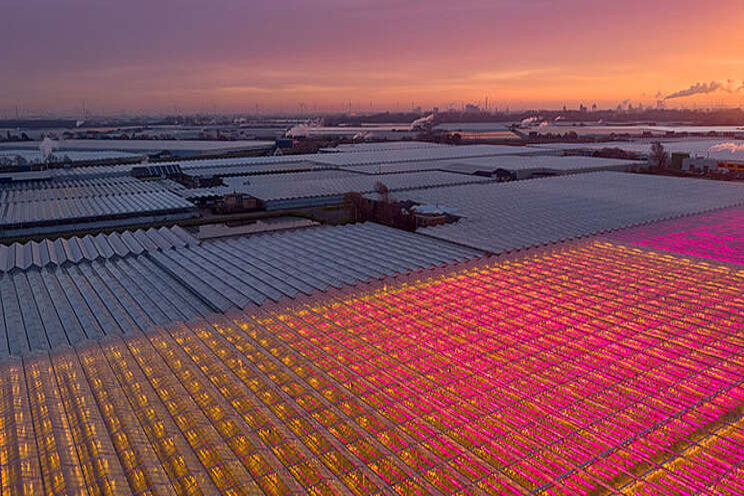6 tips for buying a commercial LED grow light
Added on 01 April 2021


These same suppliers will tell you:
"We've cracked the code for getting the most yield and highest quality out of your plants!"
The problem is that rarely does a single commercial LED manufacturer has the best grow light for EVERY environment.
For one, different plants require different light spectra to thrive. Even different varietals will respond to light spectra in different ways.
Your environment will also dictate the type of commercial lighting you need. Greenhouse lighting requires a minimal form factor so that more sunlight gets through. Whereas vertical plant racks require lighting to sit high enough above the canopy and to be spaced for the best uniformity.
In this article, we will explore the types of commercial grow lights available, and let you know what to look for before you buy the best grow light for your facility.
What is a Commercial LED Grow Light?
A commercial LED grow light is a luminaire that contains light-emitting diodes and provides illumination for growing plants. These light fixtures attach above a plant canopy in a greenhouse or indoor farm. Commercial LED grow lights must be built to withstand harsh environments commonly used in controlled environment agriculture.
How to Choose the Best Commercial LED Grow Light
There are many features to consider when choosing a commercial LED grow light. For starters, you must first decide what you're going to grow. Once you've decided what you're growing, you now need to consider the following factors before you make a purchase.
Grow Light Efficacy
Grow light efficacy, also referred to as photosynthetic photon efficacy or PPE, is the output of PAR photons divided by the fixture's wattage. Grow light efficacy has quickly become one of the primary metrics that grow light buyers look for when evaluating their options.
.
The higher the PPE the better for reducing electrical usage, though, this metric has its limitations. For instance, PPE only accounts for photons in the PAR spectrum (not including wavelengths like far-red).
Some buyers will purchase their commercial grow lights on PPE alone, though we recommend against it. PPE doesn't account for spectrum influences and fixture quality. Both of which may be more important for your application than squeezing a little more energy efficiency out of your grow lights.
Grow Light Heat Output
Long ago there was a rumor that LED grow lights don't produce heat. This is simply not true, though they are much more efficient than traditional HPS grow lights.
Generally, we recommend not worrying about differences in heat output between LED fixtures. Though you'll want to consider the advantages and disadvantages of less heat.
In colder climates, some greenhouse owners prefer the heat emitted by their HPS lamps. Although this heat may be beneficial for some, your light fixtures are not a reliable source of heat because that heat is hard to control. HPS grow lights produce heat in spots across your greenhouse, affecting plant growth in an unregulated way.
For better control and product quality, commercial LED grow lights are always best, but if you're in a cold climate and could use some extra heat at any cost, it may be worth looking to more traditional grow light technologies.
Ease-of-Installation
Commercial LED grow lights attach above a plant canopy, and depending on how far your canopy is from your plants, you need to make sure your team can easily install and replace your lights.
In a greenhouse, most commercial grow lights will attach to the unistrut running across the top of the facility. In an indoor grow room, you will be attaching to a strut, using hangers, pulleys, or attaching to a vertical plant rack.
It's usually a good idea to look at the manufacturer's installation process before making your purchase. Good manufacturers will have a well thought out system that's easy to install, replace, and scale.
Manufacturer Success
It's always good to look at a company's customer testimonials before purchasing a commercial LED grow light. Although there are some decent new LED lighting companies that may not have a record-of-success, you can expect these to largely be an exception rather than a rule.
If you do decide to go with a new grow light company, make sure that the price you are receiving reflects their lack of a track record.
Grow Light Warranty
Today, the standard for grow light warranties are generally 5 years. That said, some good quality companies will warranty for just 3 years. If you're going to be making a large investment, you think hard about de-risking your business with a warranty that satisfies your business needs.
Some growers are looking to turn a quick profit rather than building for the long-term, so if this is the case, a lower upfront investment may make sense to you versus a longer warranty.
Is Your Grow Light Made in the USA?
Deciding whether to choose a commercial LED grow light company that's made or assembled in the USA is a largely personal choice. Many that buy US-made products enjoy the collective benefit of creating more jobs for Americans and supporting our economy.
Still, whether you're interested in purchasing domestically for value-driven or financial-driven reasons, US-based manufacturers may be able to reduce delivery costs, shorten your lead times, and provide a higher standard of quality.
Source and Photo Courtesy of GroAdvisor
Source: Gro Advisor
More news















